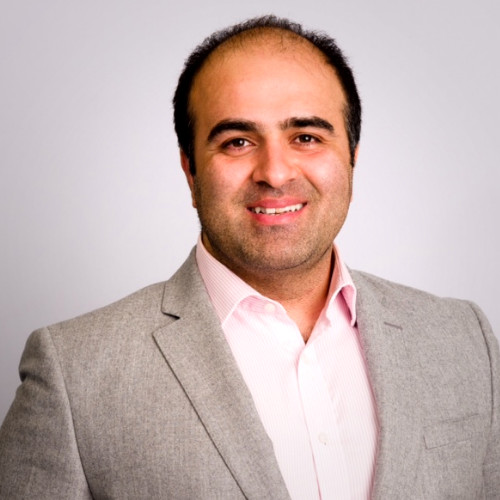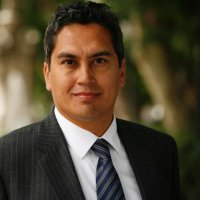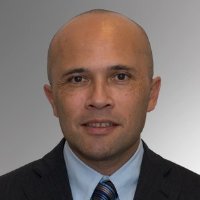
Reza, what does your role as Chief Scientist at AIG involve?
Reza: I am leading a team that is primarily focused around development of AI-first products: apps and software services that are design-led and employ machine learning to inform and assist their users. When it comes to ecosystems, I believe that AI will play a key role. Every business is becoming a software business (or at least heavily influenced by software), and it is hard to imagine software without AI these days. As Jensen Huang, NVIDIA’s CEO says: “Software is eating the world, but AI is going to eat software.”
Many different definitions are being used. How would you define ‘platforms and ecosystems’?
Reza: “I think fundamentally, ecosystems are a realization of the concept ‘sectors without borders’. The reason this became a possibility is due to the advances and the adoption of digital technologies in various industries, including insurance. As a result, companies start to integrate various offerings under one umbrella account and start to kill some of the frictions and redundancies that customers experience when they switch across related services. In the process, they are able to gather more data, which in turn allows them to create a network effect. Think of Nest for smart homes. It tells you that your neighbor is consuming less energy than you, so maybe you should do better. The network effect part is definitely an interesting aspect.”

Use the special €200 euro discount code 200DIA2018MINSURTECHN to get your ticket for DIA Munich 2018.
So, the adoption of new advanced digital technologies is one of the drivers behind the ‘platform and ecosystems’ trend. Could you mention other key drivers that make this something different than just a hype?
Reza: “One of the main drivers could be developments in adjacent industries that brought them closer to insurance. Like, if you think about Tesla, it is selling units on an average price of nearly $100,000, with a roughly 25% margin. They produce cars, they sell cars, they are actually driving the whole experience of owning a car. So why not offer an additional package that covers the rest? What is the cost of insurance for a car? $1,000? $2,000 per year? It is quite an easy business for them to say: “You know what? Every Tesla car is fully insured from now on.” The customers don’t need to go to comparethemarket.com or something.”
Which would take away frictions for customers when they have to purchase car insurance for their new car ...
Reza: “Yes. This also taps into another trend that could be a main driver for ecosystems: ever-increasing customer expectations, particularly in the consumer side of insurance. These expectations are set by the other services that consumers are interacting with, for instance, using Amazon: same-day delivery, including fresh items and everything. The convenience is at a very desired level. Then, when they go to get insurance, there is often issues around inconvenience, delays in the process, lack of transparency, and so on. None of these things are new to us in the industry; many insurers are trying to improve it. But, generally speaking, that’s one of the drivers.”

People are primarily interested in a car, not in car insurance. They are interested in a nice place to live, not necessarily in a mortgage or home insurance. In the Tesla example insurance could become invisible. So, how should insurers become part of that context? What specific platforms or ecosystems will play an important role in the future of insurance?
Reza: “Mobility and housing are the ecosystems that insurance business models seem logical to expand into. However, the reality of the competition – take the Tesla example – makes all of them a huge challenge. Personally, I really like the health ecosystem. I think we are yet to see a good ecosystem that is combining the best of finance and medical science, while making people’s life, insurance and care experience better. Most of the scientific and ecosystem building blocks are available; maybe a move by the likes of Apple, Amazon and Google in this space will eventually take us there, but insurers can start now to have an even playing field.”
So, on the one hand, building ecosystems is about moving upstream where the real question is, new ways to get access, where you can create new ways of engagement, new ways to understand customers, and transform these into new propositions. And on the other hand, it is about moving downstream.
Reza: “Sometimes you need to get closer to the customer; sometimes towards the servicing at the point of claim, and so on. Cyber is a good example. It’s an emerging risk, the landscape is moving really fast, there is not enough aggregated market data. And on top of that, the risk of a catastrophic event is extremely high. In that sort of situation, the traditional insurance offering might not work perfectly. That’s why, for example, we’ve announced a partnership with DarkTrace, an AI cyber defense company. Such alliances would enable us to move both up the value chain to prevention, using readiness diagnostics and preventive recommendations. But also down the value chain to post-breach response and support in case of attacks.”
One of the insurtechs that we featured at DIA Amsterdam was Black from Estonia. Black enables agents, brokers and MGAs to launch their own insurance products, fast. Virtually everyone agrees the cost levels of the insurance value chain are far too high. While operational excellence can bring relief, the key for dramatic change is in innovating the underlying business model – and that’s exactly what Black is all about. Black rethinks the whole value chain and brings this to the blockchain. You mentioned you were quite impressed by Black.
Reza: “Yes, the thoughtfulness of the platform was really striking. When experts and insurers think about the end-to-end value of the insurance as one – from the capital market side all the way to customer experience – sometimes it seems so complex that nobody wants to change anything about it. But when you really go back to the first principle thinking of “what is it that insurers are supposed to do?” and “how is that happening today?” and question if we could do it differently: I think the building blocks of the required ecosystems already exist out there. It is just a matter of thinking carefully about how to combine them to offer a new experience. We are seeing examples of it and I think the idea behind Black was a great example, definitely.”
Black leverages blockchain technology for its ecosystem. In your view, which technologies will play an important role to get the most out of ecosystems?
Reza: “Definitely AI. AI can be thought of as the industry’s digital ambassador to its employees and partners, for example, customers and brokers; it can make every insurance interface simple and smart. On the other hand, growth of ecosystems means more touch points, hence more data – this results in the need for more machine learning, which is ideally paired with the right UX design. The role of AI will be even more important when you see who the carriers are competing against in this ecosystem trend: think of the giant tech companies, whose main competitive edge is based on design and deployment of AI systems for the benefit of users.”
Companies such as Darktrace and Black really inspire. How important are insurtechs in platforms and ecosystems development?
Reza: “Insurtechs help our industry to respond to an important need: the need for upgrading insurance as an experience. And via partnership with insurtechs, carriers can foster innovation in new directions at a much faster pace. The industry, the whole ecosystem of incumbents and start-ups, should be mindful of what the key things are that we, as an industry, should offer to our customers. And based on that, in a synergized way, try to improve the overall ecosystem offering. It can be risky though, if insurers see partnership as an alternative to investment in internal talent diversity – particularly, in areas that are of strategic importance to them, such as machine learning and design.”

One of the keynote speakers at the recent DIA Amsterdam, Bibop Gresta, the co-founder and chairman of Hyperloop Transportation Technologies, mentioned that building an ecosystem, a community of more than 600 passionate professionals and organisations in 40+ countries has been the key success factor for Hyperloop to deliver a wide spectrum of game-changing technological breakthroughs.
Reza: “Yes, this is a significant part of what consumes my attention in terms of my role as well. It’s quite critical for us to be mindful of the fact that all the good stuff that we are talking about – transformation of the industry, innovation beyond the borders of the sector, working with insurtechs and so on have in common – we never did this traditionally as an industry. The direct implication of it is that we need to bring a new set of talent, not in terms of the core skills, but also in terms of thinking ability. When a fresh eye comes in, they can see the story very differently. The re-imagination power that a new fresh talent brings to the industry is invaluable. The other companies that have been hiring them so far are the Googles and Amazons, the successful start-ups of the world; it’s a very tough competition.”
To build new ecosystems you need to acquire different people, because it requires different skills ...
Reza: “Building ecosystems is more fundamental than sometimes some people think. When a supermarket has a website, that doesn’t make it a digital business or a technology business. This applies to our industry as well. The story is way deeper than that.
Let’s take, for example, ecosystems around health. In order for an ecosystem in health to emerge, you need to have things around medical science. Medical science itself has got a lot of deep disciplines. It could be genetics, it could be medical imaging, it could be heterogeneous data analysis, cardiology, neurology – the list goes on. On top of that, you need to understand finance of let’s say, retirement, or life insurance, or health insurance. Then, on top of that, you need to understand the users. At the end of the day, if whatever we do at the interface of finance and medicine doesn’t solve their pain, it is a waste of time and resources.”
In your view, what role should insurance carriers play in an ecosystem? When we ask this to insurance executives, opinions vary from ‘being in control’ to ‘just being one of the nodes’ to even ‘staying away from ecosystems’.
Reza: “It’s hard to come up with an answer that applies to all carriers. I think that, as an insurer, you would love to think: ‘Yes, an insurer should play a key role’. Ecosystems are considered a key disruptor – customers want it, executives understand it – so, why doesn’t it happen? I think talent is a key. A second thing is market competition. The Tesla example is a good one. I don’t think they will sit back and wait until an insurer comes in and says: ‘This mobility ecosystem is mine and I accept Tesla and GM to be part of it’. Having said that, generally speaking, insurers are in a unique place because their role in the ecosystem is regulated and is uniquely given to them, and as a result, they should use that as a reason to build on and expand further.”
What learnings would you like to share when it comes to building and nurturing ecosystems?
Reza: “The key driver of success in ecosystems will be software – referring to Mark Andreessen’s famous quote that “software is eating the world”. And in the past few years, we are seeing that software without AI, either from the beginning or as part of a future vision, is not meaningful. Therefore, it makes sense to have designers, scientists and engineers work together, from the early design of such systems.
In too many cases, various groups in a company still think strictly within their own core discipline. For instance, a data strategy is extremely likely to be developed only by the IT department, while the leading points of departure should be: why are we collecting the data? Who are we serving in this ecosystem? What new data streams should we foster? If we were to use AI for some of the touch points, what additional data do we need? Will the platform be built in a manner that can accommodate fast changes that are necessary? All the reason to actively involve other disciplines early on. As I said earlier, it’s hard to imagine software without AI these days. Therefore, you need AI scientists to be part of that thinking too. And, since everything needs to be in line with the user’s expectation, you need to have a UX expert to be part of that conversation to say: ‘We need to drive that user experience’, or: ‘That user experience could be better than AI here and there, therefore maybe we should start to collect this data here and there.’
Creating the software for ecosystems with the right applications of AI requires multidisciplinary thinking at the highest quality of talent. To me, that is the key learning. Without this multidisciplinary thinking, anything else within a company stays a theory.”
Use the special €200 euro discount code 200DIA2018MINSURTECHN to get your ticket for DIA Munich 2018.
This article was originally published in Digital Insurance Agenda




